质谱在锕系配位化学研究中的应用
2017-03-01陈秀婷李晴暖
陈秀婷,李晴暖,龚 昱,*
质谱在锕系配位化学研究中的应用
陈秀婷1,2,李晴暖1,龚 昱1,*
锕系金属离子与中性或离子型配体在溶液中所形成的配位化合物是锕系元素的重要存在形式[1]。由于乏燃料后处理过程中涉及到铀、镎、钚等锕系元素的分离[2-3],而无论萃取还是离子交换等方法,锕系元素与特定配体所形成配合物的结构特征与反应规律直接影响了分离效果,因此对于这类配合物体系的化学性质开展研究是十分必要的。另一方面,铀、钚等锕系元素特殊的电子结构(可参与成键的5f轨道以及相对论效应等),导致了它们尤其是轻锕系元素在化学行为上与镧系元素存在着明显的差异。一系列不同的稳定氧化态(+3到+7)以及存在形式使溶液中的锕系元素呈现出介于过渡金属和镧系元素的化学性质[4-6],因此探索锕系配合物所特有的结构、性质与反应方式对于深入理解锕系元素的化学性质同样有着重要的意义。
然而溶剂分子和伴阴离子等环境因素的存在,致使溶液中锕系金属离子与配体间的结合并不完全取决于锕系元素的内在性质,溶剂化效应以及离子对形成的影响不可避免,这也在一定程度上影响了锕系配合物的反应规律。相比之下,将溶液中的配合物以离子的方式引入到气相,利用质谱方法研究锕系配位化合物的结构与反应是一种有效的实验方法[7-9]。由于质谱的研究对象是具有特定质荷比的离子,选择合适的离子形式便能使伴阴离子的影响得到控制。通过优化离子的形成条件可以在质谱中得到不同程度溶剂化和无溶剂分子包围的金属配合物离子,这也为研究金属配合物的内在化学性质以及溶剂化效应创造了条件。
为了在气相中形成特定的锕系配合物离子,合适的离子化条件至关重要。尽管激光溅射金属或者简单化合物靶是制备特殊锕系化合物的有效方法[10-11],但是基于电喷雾技术的电离方式更适合将锕系配合物离子从溶液转移至气相。电喷雾电离作为一种常用的软电离技术,可以在不显著改变溶液中配合物结构和组成的情况下,实现金属配位化合物的离子化[12]。处于气相中的离子被束缚在离子阱或者离子回旋共振池等质量分析器中,这类“反应容器”为研究气相锕系配合物的结构和反应提供了必要的实验条件[13]。处于“反应容器”中的各类配合物离子经过质量选择这一“分离”和“纯化”步骤可以得到单一的反应物或产物,随后利用碰撞诱导解离(CID)[14]、电子转移解离(ETD)[15]等技术以及室温条件下的分子离子反应[16-17]便能对特定离子的结构和反应展开研究。
近五年来,基于质谱方法的气相锕系化学研究已经取得了一系列研究成果,涵盖了钍、镤、铀、镎、钚、镅、锔等众多锕系元素。本文将从多电荷锕系配合物离子的形成和反应、锕酰离子的氧化与活化反应等方面介绍锕系元素的氧化态、存在形式、电荷密度以及配体性质对锕系配合物在结构和反应等方面的影响。
1 多电荷锕系配合物离子的形成和反应






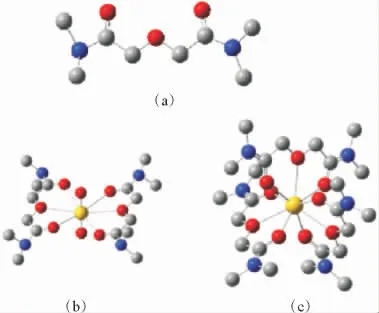
红:O;蓝:N;灰:C;黄:An;氢原子省略图及的结构示意图Fig.1 Structures of TMOGA(a),

1.2 An3+和An4+配合物的形成与反应

A:AnⅣ; B:AnⅢ;C:PuⅣ(L)2(86)3+;D:AnⅣ(L)2(L-86)3+图的碰撞诱导裂解反应[26]Fig.2 Collison induced dissociation of An(L)


综上所述,四价锕系金属离子在气相中的还原稳定性顺序依次为Th(Ⅳ)>U(Ⅳ)>Np(Ⅳ)>Pu(Ⅳ),这也与溶液中四者的氧化还原趋势一致。鉴于四价镤、镅和锔同样具有相当的稳定性,对它们所形成配合物的研究将能更全面地反映出四价锕系金属离子在反应规律上的异同及其影响因素。
2 锕酰离子的氧化与活化反应





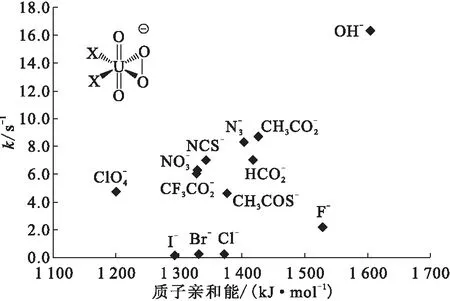
图3 UⅤ的氧化反应速率与配体X质子亲和能的关系[34]Fig.3 Plot of the rates of O2 addition to UⅤas a function of the gas basicity of X-[34]


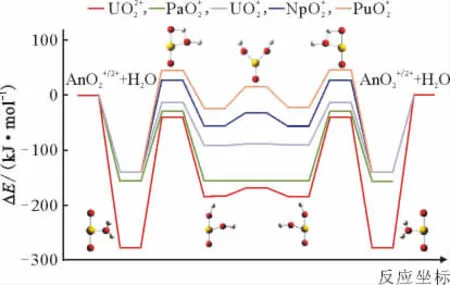
红:O;灰:H;黄:An图4 锕酰离子与水的氧交换反应势能面Fig.4 Potential energy profiles for the oxo-exchange





图的碰撞诱导裂解反应[45]Fig.5 Collision induced dissociation of UO2(NCO)

3 锕酰离子-冠醚配合物的结构


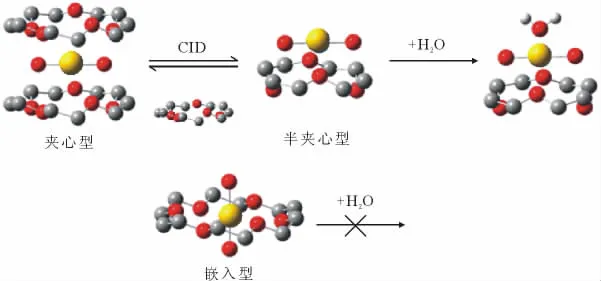
红:O;灰:C;黄:An;氢原子省略图6冠醚配合物的结构及其水合行为示意图Fig.6 Schematic structures of actinyl-crown ether complexes and their reactivities toward H2O

4 配位诱导的化学反应
锕系配合物离子在气相中的化学反应除了与金属离子的性质密切相关外,配体自身的反应规律也有着重要的影响。通常情况下,处于结合状态的配体只有在得到额外能量的时候才能引发自身的反应,该能量既可以来自于光激发也可以来自于CID过程,这一点已为人们所熟知。除此以外,锕系配合物与另一分子因配位而释放的反应热同样能够诱导与金属结合配体的化学反应。

5 铀酰离子的电荷密度

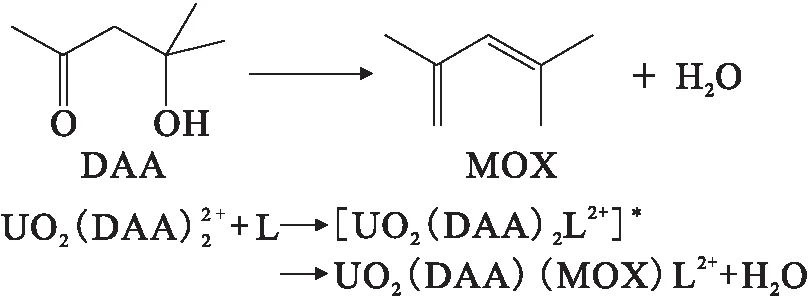
图7 DAA的脱水反应(上)与铀酰离子存在下DAA的配位诱导解离反应(下)Fig.7 Dehydrations of DAA in condensedphase induced by spectator-ligand-addition(bottom)


图配合物的两种裂解方式Fig.8 Fragmentation patterns

6 结语与展望
基于质谱的气相化学研究在锕系配合物的制备、表征和反应机理探索方面展现出独特的作用。由于气相条件下溶剂分子和伴阴离子等环境因素的影响可以得到有效地控制,因此实验结果能够更好地反映出锕系元素内在性质对反应规律的影响。同时通过选择合适的离子体系,借助CID、分子离子反应等方法可以在气相中实现溶液中不易发生的化学反应,使锕系元素在溶液中被“隐藏”的化学性质得以体现。处于气相中的锕系配合物通常都是简单分子离子,这也使基于从头计算和密度泛函理论的量子化学计算能够对其进行比较准确地模拟[11,57-58],通过与实验现象的对比进而得出诸如电子结构、化学键等对锕系化合物结构、性质和反应的影响。近些年来,随着负离子光电子能谱[59-60]、红外光解离光谱[61-62]等各种质谱相关的新型实验技术在气相锕系化学研究中得到应用,实验自身已经能够给出许多与配合物离子结构、电子结构直接相关的信息。另一方面,大气压化学电离、激光溅射电离等多种电离方式的应用也使更多性质各异的固态和液态化合物易于离子化,这些都极大地拓展了气相化学研究的范围。尽管质谱方法的研究对象是气相配合物离子,但是实验得到的结果往往与配合物在溶液中的化学行为直接相关。结合红外光谱、核磁共振、X射线吸收和衍射等技术,便可以在不同层次上深入认识各类锕系配位化合物的结构特征和反应规律,在阐明锕系元素化学性质的同时,也能为乏燃料后处理等过程中涉及的锕系配位化学问题提供必要的科学依据。
[1] Morss L R, Edelstein N M, Fuger J. The chemistry of the actinide and transactinide elements[M]. Dordrecht, Netherlands: Springer, 2011.
[2] 张生栋,严叔衡.乏燃料后处理湿法工艺技术基础研究发展状况[J].核化学与放射化学,2015,37(5):266-275.
[3] Panak P J, Geist A. Complexation and extraction of trivalent actinides and lanthanides by triazinylpyridine N-donor ligands[J]. Chem Rev, 2013, 113(2): 1199-1236.
[4] Jones M B, Gaunt A J. Recent developments in synthesis and structural chemistry of nonaqueous actinide complexes[J]. Chem Rev, 2013, 113(2): 1137-1198.
[5] Altmaier M, Gaona X, Fanghänel T. Recent advances in aqueous actinide chemistry and thermodynamics[J]. Chem Rev, 2013, 113(2): 901-943.
[6] Liddle S T. The renaissance of non-aqueous uranium chemistry[J]. Angew Chem Int Ed Engl, 2015, 54(30): 8604-8641.
[7] O’Hair R A J. The 3D quadrupole ion trap mass spectrometer as a complete chemical laboratory for fundamental gas-phase studies of metal mediated chemistry[J]. Chem Commun, 2006, 14(14): 1469-1481.
[8] Detlef S D. Applications of electrospray ionization mass spectrometry in mechanistic studies and catalysis research[J]. Acc Chem Res, 2012, 45(9): 1521-1532.
[9] O’Hair R A J, Rijs N J. Gas phase studies of the pesci decarboxylation reaction: synthesis, structure, and unimolecular and bimolecular reactivity of organometallic ions[J]. Acc Chem Res, 2015, 48: 329-340.
[10]Gibson J K, Marçalo J. New developments in gas-phase actinide ion chemistry[J].Coor Chem Rev, 2006, 250(7-8): 776-783.
[11]Kovacs A, Konings R J M, Gibson J K, et al. Quantum chemical calculations and experimental investigations of molecular actinide oxides[J]. Chem Rev, 2015, 115(4): 1725-1759.
[12]Henderson W, McIndoe J S. Fundamentals: mass spectrometry of inorganic, coordination and organometallic compounds[M]. US: Wiley, 2005.
[13]Asamoto B. FT-ICR/MS: analytical applications of Fourier transform ion cyclotron resonance mass spectrometry[M]. New York: VCH, 1991.
[14]McLuckey S A, Goeringer D E. Specialfeature: tutorial slow heating methods in tandem mass spectrometry[J]. J Mass Spectrom, 1997, 32(5): 461-474.
[15]Rios D, Rutkowski P X, Shuh D K, et al. Electron transfer dissociation of dipositive uranyl and plutonyl coordination complexes[J]. J Mass Spectrom, 2011, 46(12): 1247-1254.
[16]Gronert S. Quadrupole ion trap studies of fundamental organic reactions[J]. Mass Spectrom Rev, 2005, 24(1): 100-120.
[17]Donald W A, Khairallah G N, O’Hair R A J. The effective temperature of ions stored in a linear quadrupole ion trap mass spectrometer[J]. J Am Soc Mass Spectrom, 2013, 24(6): 811-815.
[18]Schröder D. Coulomb explosions and stability of multiply charged ions in the gas phase[J]. Angew Chem Int Ed Engl, 2004, 43(11): 1329-1331.
[19]Van Stipdonk M J, Chien W, Anbalagn V, et al. Gas-phase complexes containing the uranyl ion and acetone[J]. J Phys Chem A, 2004, 108(47): 10448-10457.

[22]Gong Y, Hu H, Rao L, et al. Experimental and theoretical studies on the fragmentation of gas-phase uranyl-, neptunyl-, and plutonyl-diglycolamide complexes[J]. J Phys Chem A, 2013, 117(40): 10544-10550.
[23]Tian G, Shuh D K, Beavers Ch M, et al. A structural and spectrophotometric study on the complexation of Am(Ⅲ) with TMOGA in comparison with the extracted complex of DMDOOGA[J]. Dalton Transactions, 2015, 44(42): 18469-18474.
[24]Reilly S D, Gaunt A J, Scott B L, et al. Plutonium(Ⅳ) complexation by diglycolamide ligands-coordination chemistry insight into TODGA-based actinide separations[J]. Chem Commun, 2012, 48(78): 9732-9734.
[25]Gong Y, Hu H, Tian G, et al. A tetrapositive metal ion in the gas phase: thorium(Ⅳ) coordinated by neutral tridentate ligands[J]. Angew Chem, 2013, 125(27): 7023-7026.
[26]Gong Y, Tian G, Rao L F, et al. Tetrapositive plutonium, neptunium, uranium, and thorium coordination complexes: chemistry revealed by electron transfer and collision induced dissociation[J]. J Phys Chem A, 2014, 118(15): 2749-2755.
[27]Gong Y, Tian G, Rao L, et al. Dissociation of diglycolamide complexes of Ln3+(Ln=La-Lu) and An3+(An= Pu, Am, Cm): redox chemistry of 4f and 5f elements in the gas phase parallels solution behavior[J]. Inorg chem, 2014, 53(22): 12135-12140.
[28]Shkrob I A, Marin T W, Bell J R, et al. Radiation-induced fragmentation of diamide extraction agents in ionic liquid diluents[J]. J Phys Chem B, 2012, 116(7): 2234-2243.
[29]Arnold P L, Love J B, Pate D. Pentavalent uranyl complexes[J]. Coord Chem Rev, 2009, 253(15-16): 1973-1978.
[30]Groenewold G S, Cossel K C, Gresham G L, et al. Binding of molecular O2to di-and triligated [UO2]+[J]. Am Chem Soc, 2006, 128: 3075-3084.
[31]Bryantsev V S, de Jong W A, Cossel K C, et al. Two-electron three-centered bond in side-on(η2-O2) uranyl(Ⅴ) superoxo complexes[J]. J Phys Chem A, 2008, 112: 5777-5780.
[32]Leavitt C M, Bryantsev V S, de Jong W A, et al. Addition of H2O and O2to acetone and dimethylsulfoxide ligated uranyl(Ⅴ) dioxocations[J]. J Phys Chem A, 2009, 113: 2350-2358.
[33]Rios D, Michelini M C, Lucena A F, et al. Gas-phase uranyl, neptunyl, and plutonyl: hydration and oxidation studied by experiment and theory[J]. Inorg Chem, 2012, 51(12): 6603-6614.
[34]Lucena A F, Carretas J M, Marçalo J, et al. Gas-phase reactions of molecular oxygen with uranyl(Ⅴ) anionic complexes synthesis and characterization of new superoxides of uranyl(Ⅵ)[J]. J Phys Chem A, 2015, 119(15): 3628-3635.
[35]Dau P D, Carretas J M, Marcalo J, et al. Oxidation of actinyl(Ⅴ) complexes by the addition of nitrogen dioxide is revealed via the replacement of acetate by nitrite[J]. Inorg Chem, 2015, 54(17): 8755-8760.
[36]Dau P D, Wilson R E, Gibson J K. Elucidating protactinium hydrolysis: the relative stabilities of PaO2(H2O)+and PaO(OH)2+[J]. Inorg Chem, 2015, 54(15): 7474-7480.
[37]Rios D, del Carmen M M, Lucena A F, et al. On the origins of faster oxo exchange for uranyl(Ⅴ) versus plutonyl(Ⅴ)[J]. J Am Chem Soc, 2012, 134(37): 15488-15496.
[39]Lucena A F, Odoh S O, Zhao J, et al. Oxo-exchange of gas-phase uranyl, neptunyl, and plutonyl with water and methanol[J]. Inorg Chem, 2014, 53(4): 2163-2170.
[40]Arnold P L, Pecharman A F, Hollis E, et al. Uranyl oxo activation and functionalization by metal cation coordination[J]. Nat Chem, 2010, 2: 1056-1061.
[41]Sarsfield M J, Helliwel M. Extending the chemistry of the uranyl ion: lewis acid coordination to a U=O oxygen[J]. J Am Chem Soc, 2004, 126: 1036-1037.
[42]Schnaars D D, Wu G, Hayton T W. Silylation of the uranyl ion using B(C6F5)3-activated Et3SiH[J]. Inorg Chem, 2011, 50: 9642-9649.
[43]Arnold P L, Patel D, Wilson C, et al. Reduction and selective oxo group silylation of the uranyl dication[J]. Nat, 2008, 451: 315-317.
[44]Berthet J C, Siffredi G, Thuery P, et al. Controlled chemical reduction of uranyl salts into UX4(MeCN)4(X=Cl, Br, I) with Me3SiX reagents[J]. Eur J Inorg Chem, 2007: 4017-4020.
[45]Gong Y, Vallet V, del Carmen Michelini M, et al. Activation of gas-phase uranyl: from an oxo to a nitrido complex[J]. J Phys Chem A, 2013, 118(1): 325-330.
[46]Dau P D, Armentrout P B, Michelini M C, et al. Activation of carbon dioxide by a terminal uranium-nitrogen bond in the gas-phase: a demonstration of the principle of microscopic reversibility[J]. Phys Chem Chem Phys, 2016, 18(10): 7334-7340.
[48]Gong Y, de Jong W A, Gibson J K. Gas phase uranyl activation: formation of a uranium nitrosyl complex from uranyl azide[J]. J Am Chem Soc, 2015, 137(18): 5911-5915.
[49]Deshayes L, Keller N, Lance M, et al. EXAFS analysis of aqueous and acetonitrile solutions of UO2-triflate with crown-ethers and aza-crowns: crystals structures of the inclusion complexes UO2(18-crown-6)(CF3SO3)2and UO2(dicyclohexyl-18-crown-6)(CF3SO3)2[J]. Polyhedron, 1994, 13: 1725-1733.
[50]Clark D L, Keogh D W, Palmer P D, et al. Synthesis and structure of the first transuranium crown ether inclusion complex: [NpO2(18-crown-6)]ClO4[J]. Angew Chem, Int Ed, 1998, 37: 164-166.
[51]Rogers R D, Bond A H, Hipple W G, et al. Synthesis and structural elucidation of novel uranyl-crown ether compounds isolated from nitric, hydrochloric, sulfuric, and acetic acids[J]. Inorg Chem, 1991, 30: 2671-2679.
[52]Gong Y, Gibson J K. Crown ether complexes of uranyl, neptunyl, and plutonyl: hydration differentiates inclusion versus outer coordination[J]. Inorg Chem, 2014, 53(11): 5839-5844.
[53]Rios D, Schoendorff G, Van Stipdonk M J, et al. Roles of acetone and diacetone alcohol in coordination and dissociation reactions of uranyl complexes[J]. Inorg Chem, 2012, 51: 12768-12775.
[54]Rios D, Gibson J K. Activation of gas-phase uranyl diacetone alcohol coordination complexes by spectator ligand addition[J]. Eur J Inorg Chem, 2012, 2012(7): 1054-1060.
[55]Choppin G R, Rao L F. Complexation of pentavalent and hexavalent actinides by fluoride[J]. Radiochim Acta, 1984, 3: 143-146.
[56]Lucena A F, Carretas J M, Marcalo J, et al. Dissociation of gas-phase bimetallic clusters as a probe of charge densities: the effective charge of uranyl[J]. J Phys Chem A, 2014, 118(11): 2159-2166.
[57]Wang D, van Gunsteren W F, Chai Z. Recent advances in computational actinoid chemistry[J]. Chem Soc Rev, 2012, 41(17): 5836-5865.
[58]Pepper M, Bursten B E. The electronic structure of actinide-containing molecules: a challenge to applied quantum chemistry[J]. Chem Rev, 1991, 91(5): 719-741.
[61]Ricks A M, Gagliardi L, Duncan M A. Uranium oxo and superoxo cations revealed using infrared spectroscopy in the gas phase[J]. J Phys Chem Lett, 2011, 2(14): 1662-1666.
1.中国科学院 上海应用物理研究所,上海 201800;2.中国科学院大学,北京 100049
锕系配位化合物不仅是乏燃料后处理所涉及的重要物种,也是探究锕系元素性质对化合物结构特征与反应规律影响的重要模型,因此对于这类配合物体系开展研究是十分必要的。处于气相中的锕系配合物离子由于溶剂分子、伴阴离子等环境因素得到了有效的控制,它们的化学行为更准确地体现出锕系元素内在性质的影响。本文将对近五年来质谱方法在气相锕系配合物的制备、表征和反应机理研究方面所取得的主要研究成果进行介绍。
锕系元素;配位化合物;质谱;气相
Mass Spectrometric Studies on the Chemistry of Actinide Coordination Complexes
CHEN Xiu-ting1,2, LI Qing-nuan1, GONG Yu1,*
1.Shanghai Institute of Applied Physics, Chinese Academy of Sciences, Shanghai 201800, China;2.University of Chinese Academy of Sciences, Beijing 100049, China
Actinide coordination complexes are not only important species involved in nuclear fuel cycle, but also serve as model systems from which the influence of 5f electron as well as relativistic effect on the structures and reactivities of actinide complexes can be derived. Investigations on actinide coordination complexes in solution are usually complicated due to the presence of solvent molecules and counterpart anions, while all these effects could be under control when the coordination chemistry of actinide complexes is probed in the gas phase. With the help of various gas phase dissociation techniques, ion-molecule reactions as well as quantum chemical calculations, the intrinsic properties of actinide elements and their influences on the gas phase chemistry of actinide complexes are unveiled. Herein, recent progresses on multiply charged actinide complexes, actinyl oxidation and activation, actinyl-crown ether complexes, spectator-ligand-addition induced reaction and effective charge densities of actinyls are presented. The discussion is mainly focused on the formation, characterization and reaction mechanism of these actinide coordination complexes.
actinide; coordination complexes; mass spectrometry; gas phase
2016-06-14;
2016-09-04
中国科学院战略性先导科技专项(XDA02030000);“千人计划”青年人才项目;留学人员科技活动项目
陈秀婷(1991—),女,江西宜春人,博士研究生,从事锕系配位化合物的气相化学研究;E-mail: chenxiuting@sinap.ac.cn
*通信联系人:龚 昱(1982—),男,上海人,研究员,从事锕系元素化学研究,E-mail: gongyu@sinap.ac.cn
O641.4;O657.63
A
0253-9950(2017)01-0001-12
10.7538/hhx.2017.39.01.0001
